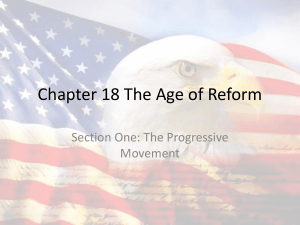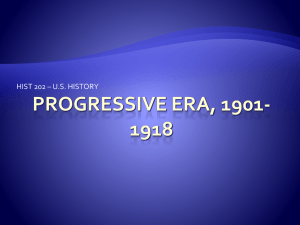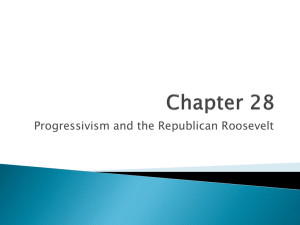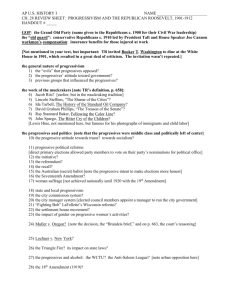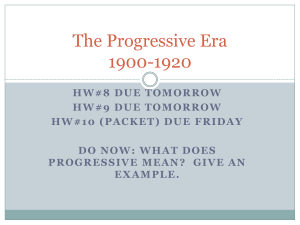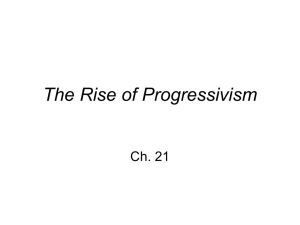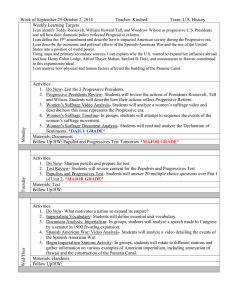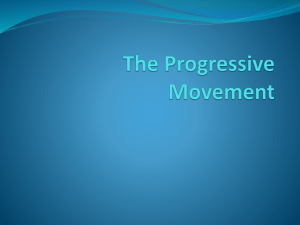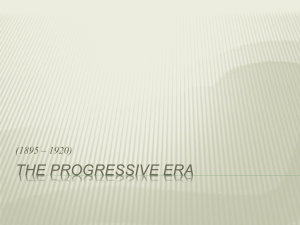Progressive Era SGQ
advertisement
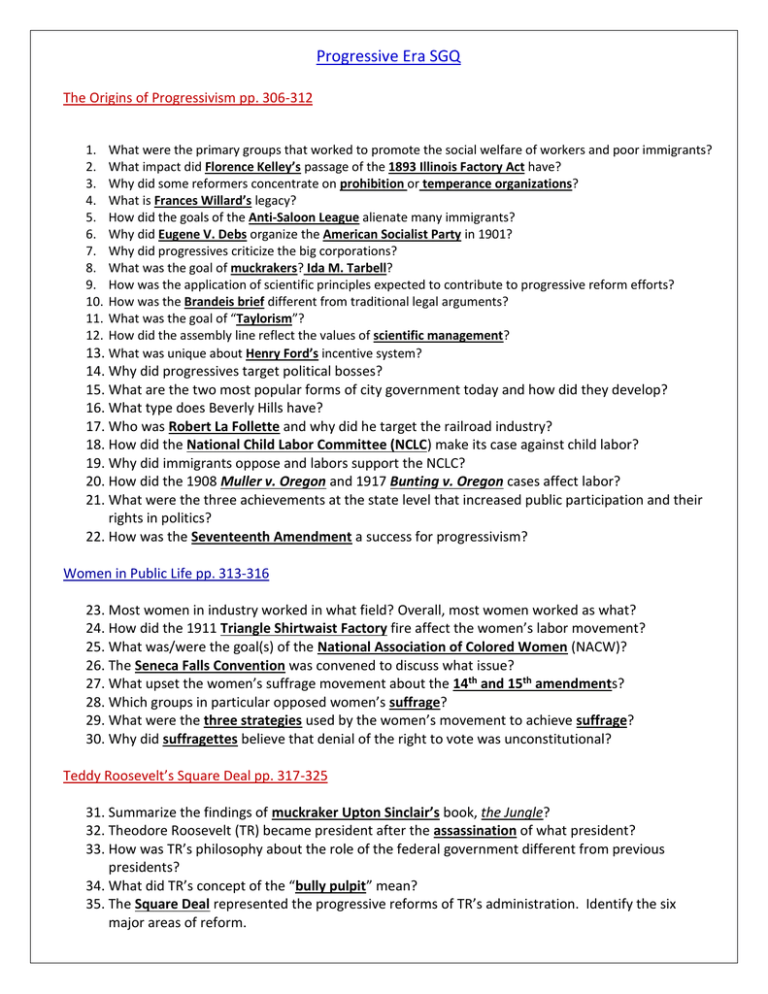
Progressive Era SGQ The Origins of Progressivism pp. 306-312 1. 2. 3. 4. 5. 6. 7. 8. 9. 10. 11. 12. What were the primary groups that worked to promote the social welfare of workers and poor immigrants? What impact did Florence Kelley’s passage of the 1893 Illinois Factory Act have? Why did some reformers concentrate on prohibition or temperance organizations? What is Frances Willard’s legacy? How did the goals of the Anti-Saloon League alienate many immigrants? Why did Eugene V. Debs organize the American Socialist Party in 1901? Why did progressives criticize the big corporations? What was the goal of muckrakers? Ida M. Tarbell? How was the application of scientific principles expected to contribute to progressive reform efforts? How was the Brandeis brief different from traditional legal arguments? What was the goal of “Taylorism”? How did the assembly line reflect the values of scientific management? 13. What was unique about Henry Ford’s incentive system? 14. Why did progressives target political bosses? 15. What are the two most popular forms of city government today and how did they develop? 16. What type does Beverly Hills have? 17. Who was Robert La Follette and why did he target the railroad industry? 18. How did the National Child Labor Committee (NCLC) make its case against child labor? 19. Why did immigrants oppose and labors support the NCLC? 20. How did the 1908 Muller v. Oregon and 1917 Bunting v. Oregon cases affect labor? 21. What were the three achievements at the state level that increased public participation and their rights in politics? 22. How was the Seventeenth Amendment a success for progressivism? Women in Public Life pp. 313-316 23. Most women in industry worked in what field? Overall, most women worked as what? 24. How did the 1911 Triangle Shirtwaist Factory fire affect the women’s labor movement? 25. What was/were the goal(s) of the National Association of Colored Women (NACW)? 26. The Seneca Falls Convention was convened to discuss what issue? 27. What upset the women’s suffrage movement about the 14th and 15th amendments? 28. Which groups in particular opposed women’s suffrage? 29. What were the three strategies used by the women’s movement to achieve suffrage? 30. Why did suffragettes believe that denial of the right to vote was unconstitutional? Teddy Roosevelt’s Square Deal pp. 317-325 31. Summarize the findings of muckraker Upton Sinclair’s book, the Jungle? 32. Theodore Roosevelt (TR) became president after the assassination of what president? 33. How was TR’s philosophy about the role of the federal government different from previous presidents? 34. What did TR’s concept of the “bully pulpit” mean? 35. The Square Deal represented the progressive reforms of TR’s administration. Identify the six major areas of reform. 36. Give an example of an unfair business practice used by Standard Oil and other trusts that were detrimental to the public’s interests? 37. What legal authority did TR use to break up the trusts? 38. Did he believe that all trusts were harmful? Which did he go after? 39. Why did he go after the Northern Securities Company and was he successful? 40. What threat did TR make to the coal mine owners during the 1902 Coal Mine Strike? 41. How was the strike settled? 42. According to TR what new principle justified his intervention in this strike? 43. The Elkins and Hepburn Acts were designed to remove unfair business practices in what industry? 44. What do you think was the most effective example of railroad regulation in the Hepburn Act? 45. What led to and what were the results of the 1906 Meat Inspection Act? 46. What problems did the 1906 Pure Food and Drug Act attempt to remedy? 47. How did the conservation views of TR and Gifford Pinchot differ from those of naturalist, John Muir? 48. Would you support or condemn the 1902 National Reclamation Act (Newlands Act)? Why or why not? 49. In what area did TR fail in promoting meaningful reform? 50. Explain the principle philosophical differences between Booker T. Washington and W.E.B. Du Bois? 51. What is one of WEB Du Bois’ greatest contributions? 52. Do you think most progressives or whites in general supported the National Association for the Advancement of Colored People’s (NAACP) goals then? Now? Progressivism Under Taft pp. 328-331 53. Were critics justified in their criticism of Taft in the field of tariffs and conservation? 54. What role did TR envision in his “New Nationalism”? 55. How did the Bull Moose Party come into being? 56. What was TR’s progressive platform? 57. Which of the candidates in the 1912 election was the most radical? Most conservative? 58. Why do you think that TR lost the 1912 election? Wilson’s New Freedom pp. 332- 337 59. In what ways was the Clayton Antitrust Act progressive? 60. Who was Samuel Gompers and what did he mean when he called the Clayton Antitrust Act the Magna Carta for labor? 61. In what ways was the Federal Trade Commission a “watchdog agency”? 62. Why do you think the business and manufacturing lobbyists opposed the Underwood Act? 63. What was the justification for the Sixteenth Amendment? 64. What is the major source of the federal government’s revenue today? 65. How does the Federal Reserve System strengthen the country’s banking system then and now? 66. What were the principle differences between the NAWSA headed by Carrie Chapman Catt and the Congressional Union (later called the National Woman’s Party) headed by Alice Paul and Lucy Burns? 67. How did WW justify opposition to a federal anti-lynching law? 68. How would you evaluate WW’s civil rights record? 69. Why do you think that progressive reforms would be least likely to be discussed and/or achieved on the eve or during war?
